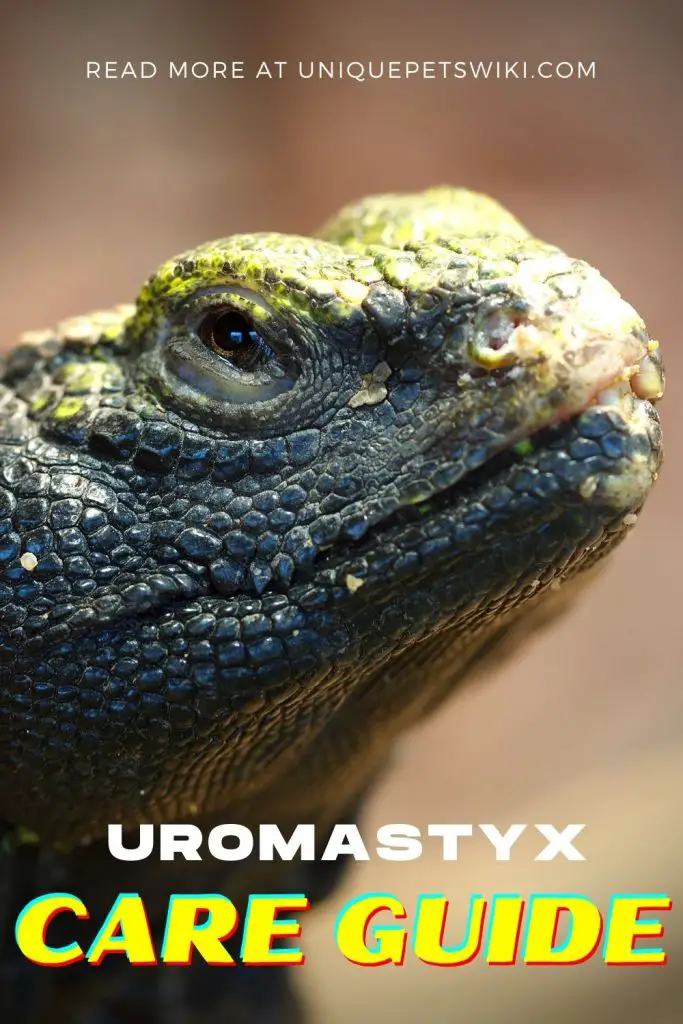Uromastyx are fascinating creatures that every reptile lover would love to own. However, they are mostly described as suitable for intermediate and advanced keepers.
Even so, if you are a beginner and would love to own one, all you have to do is put in a little more effort and time to learn about their needs.
For these reasons, we came up with this article with a complete care guide to help you succeed in uromastyx care.
By the end of this article, you will understand where you can get your uromastyx and even care for it.
Contents
What Are Uromastyx?

Uromastyx are dessert adopted lizards that have spiny-tails. There are approximately 14 different species. However, only a few species are bred in captivity.
Though Uromastyx are primarily known as herbivorous, they occasionally feed on insects and other small animals.
Appearance and Origin
Uromastyx comes in a variety of colors depending on their originality. Even so, they are mostly dull when the weather is cold and lighten up when it’s warm.
Uromastyx lizards are common in some parts of Africa and Asia.
Gender Difference and Mating
Uromastyxs are sexually dimorphic. Thus, it is not difficult to differentiate a male uromastyx from a female.
For instance, male uromastyx have larger heads, are more colorful, and are wider at the base of their tails.
Additionally, you can check your uromastyx gender by identifying hemipenis bulges. Male uromastyx has two nodes at the base of their tail, while females have one or none.
The bulges can be seen on either side of the tail. Also, male uromastyx have large femoral pores on the underside of their thighs.
The female’s pores are tiny and can hardly be seen. However, this method can be used only when your uromastyx is mature.
Why Does Uromastyx Make Good Pets?
Uromastyx makes excellent pets as they are docile, social, and easy to care for. Compared to other reptiles, it is relatively inexpensive to set up a uromastyx habitat.
It is also easy to find uromastyx food as they mostly feed on common vegetables readily available in grocery stores.
Fun Facts about Uromastyx
- Uromastyx can survive without water even in hot weather of approximately 1150F.
- Uromastyxs are antisocial. Thus, they are very aggressive towards each other.
- Uromastyx can hibernate 2-5 months during winter.
- Uromastyx comes from a Greek word meaning “oura” (tail) and “mastyx” (whip).
- Uromastyx can lay 6-23 eggs and usually mate in April.
- Uromastyx changes color and becomes dull when cold. Change of color helps them absorb more heat and becomes brighter when they are too hot.
- They use their spiked tails to hit their predators. Also, they use their tail to wedge themselves when sleeping in burrows.
- They have a long life span as they can live for up to 35 years.
The Cost of Caring For and Raising Uromastyx

The cost of caring for and raising uromastyx may vary from one pet owner to another. To help you approximate the amount it would cost you to keep one, we will break down the cost for each uromastyx requirements.
How Much Do Uromastyx Cost?
The cost of buying a uromastyx depends on the species. Most species cost between $75-300. However, some like Omani uromastyx are quite expensive.
It can cost you approximately $999.99 as it is a rare species. The cost of uromastyx is just a fraction, considering how much it can cost you to raise and care for one.
Cost for Cage Setup
Cage setup includes tank, lighting, heating, and substrate. The best tank size for an adult uromastyx is 50 gallons, which costs approximately $75-100. Heating and lighting bulbs can cost roughly $150. You should replace lighting bulbs every six months.
Cost for Food
Uromastyxs are primarily herbivorous. Thus, they mostly feed on plant matter such as leafy greens, vegetables, and occasional insects. Buying vegetables for your uromastyx depends on your location.
However, the approximate cost of vegetables is $10- 30 a month. Other costs for food include supplements and insects, which can cost $20 per year.
Cost for Cohabitation
It is inadvisable to cohabitate uromastyx. However, if you have to cohabitate uromastyx, you must ensure that you provide a large tank as uromastyx are terrestrial animals.
It would be best to provide several eating spots, hides, and a large tank for each to move around. The cost of setting up two uromastyx can go up by 50%.
Medical Costs for Uromastyx
It can cost you $100- $125 annually to pay for veterinary services. However, if you provide a suitable environment for your uromastyx, it is less likely to get ill.
Proper diet and suitable habitation contribute to a healthy pet. Therefore, it’s wiser to invest in a good diet and housing to prevent uromastyx health problems.
Where Can I Buy Uromastyx?

There are plenty of sites where you can buy Uromastyx. These sites range from pet stores, breeders, classified Ads/Facebook Groups, and reptile rescues.
Wherever choice you make, just ensure that you get a captive-bred uromastyx, especially if you are a beginner.
Pet Stores
It’s simple to buy your uromastyx from your local pet store. It can be fun as you will personally meet your pet before purchasing it.
Buying in a pet store comes with pros as well as cons.
Pros
- Guarantee in case your pet falls ill after a short period after purchase.
- It’s possible to choose your favorite pet from the various available pets.
- Stores can advise on the most sought after species and order the same for you.
Cons
- Can be expensive
- Inexperienced employees
- Overcrowding and illness
Breeders
Breeders are more enthused about their animals compared to pet store owners. Therefore, they are better sellers as they are more likely to offer healthy pets.
Pros
- Availability of unique morphs and species
- You get a tamed pet
- It’s easy to get the most recommended breeder from reptile communities.
Cons
- Can be expensive
Classified Ads/Facebook Groups
With technology today, uromastyx enthusiasts have Facebook groups where they can connect. Inexperienced pet owners can join the groups and get to interact with the breeders as well as purchase.
Pros
- You can get referrals for the best breeders.
- You learn from experienced breeders.
- You can ask questions from group members. The answers they give are from experience.
Cons
- Con people hide in Facebook groups, and they can rip you off.
- You have to request a group admin to add you to the Facebook group.
Reptile Rescues
Adopting uromastyx from reptile rescues is inexpensive. However, you must be mentally prepared to face challenges that come along with it.
For instance, there are not many species to choose from, and most of them have a terrible past that makes them aggressive.
Even so, adopting uromastyx from reptile rescue is like offering it a second chance.
Pros
- Cheap
- You will be giving the uromastyx a new life to live.
Cons
- The reptile rescue team can deny your application if you don’t meet the requirements.
- There’s usually not much information about their past.
Home set up for uromastyx
Home setup for uromastyx is the first stage of owning uromastyx. It is, therefore, necessary to ensure that you have everything ready before bringing in your pet.
Proper cage setup includes tank, lighting and heating, cage accessories, and dishes and bowls.
Tank
You are probably wondering, which tank to choose, which size is ideal, and more? Uromastyx tanks come in two designs; wooden and glass tanks. You can decide on the size of your tank according to the age of your uromastyx.
Choose a good quality PVC cage tank made from PVC sturdy that is long-lasting and looks great. Choose the right temperature and lighting for the tank. Consider also getting a hood for the tank for efficiency.
Basking Accessories like Branches, Rocks, And Hiding Holes
Uromastyx doesn’t need plants and decorations. Hiding spots and basking rocks are the most important because they like digging holes, climbing, and hiding.
Large logs and rocks that are closer to the basking bulb are often optimal. Your uromastyx will climb on to bask.
Uromastyx love jamming themselves into tight spots to hide. Thus, you should include more hiding spots.
For this, you can add lots of slate rocks, roofing tiles, slabs, flipped upside down terracotta planters, egg crates, and more. You can stack them to create entrances and exits. Ensure they are stable and can’t fall.
Depending on the size of your uromastyx, it should be able to get enough space to hide freely. Include at least two hides on each side of the tank.
Dishes and Bowls
Some uromastyx are chosen on food bowls and even positioning, so you’ll experiment thereupon. Choose a large shallow bowl for salads, and possibly another small one for occasional seeds and lentils.
Uromastyx generally doesn’t need a water bowl, but you can place a very shallow dish once a week. Placing a soaking bowl could cause respiratory infection and more. Uromastyx doesn’t need soaking/bathing unless very dehydrated.
How do I choose the right uromastyx for me?
Getting the right uromastyx could be challenging; however, there are many domesticated pets, but each has specific needs, characteristics, and personality traits.
Within a category of pets, each breed will flourish in different surroundings and different treatments. Choosing the right pet in this competitive field will depend on tame and care.
Thus getting adequate information regarding their cost, dietary and environmental requirements is necessary because the species that you choose should be available. Their needs should not be complicated too.
Ultimate Uromastyx Care Guide

Uromastyxs are diurnal. Thus, they are mostly active during the day, especially morning hours.
These lizards mostly live in desert-like regions or arid areas. They, therefore, need specific temperatures and humidity to triumph in captivity.
This guide will give you the ultimate care guide starting from housing, feeding, and health issues.
Diet
Like we stated earlier, uromastyx dwells in desert-like areas. Thus, their diet is relatively high in fiber and low in nutrients.
In the wild, these lizards diet mostly consist of tough grasses and other leafy green plants.
In captivity, you must ensure to provide a similar diet for them to thrive. Since uromastyx are mainly herbivorous, you should ensure that 96% of the diet is nutritious plants.
Getting a uromastyx diet is never a challenge, as you can find them in your local grocery store. Also, you can plant those herbs in your kitchen to bring the cost down.
Some of the best vegetables to offer your uromastyx include
Green leafy
- Collards
- Dandelion
- Mustard
- Turnip greens,
- Cilantro
- Kales
- Romaine
- Cloy
- Among other green leafs
Seeds
It is necessary to feed uromastyx with seeds to supplement for proteins. Some of the best seeds include dried lentils, split peas, and almonds, among others.
Flowers
Flowers are also a significant part of the uromastyx diet. Some of the best flowers to feed your uromastyx are honeysuckle, hibiscus, rose of Sharon, dandelion, rose, among others.
Insects
Insects should only consist of 4% of your uromastyx diet. However, it’s not necessary to add to the uromastyx diet.
But, if you must include insects in your uromastyx diet, only add it as an occasional treat.
Dietary supplements
Adding vitamin supplements is a plus. Dietary supplements make up for the missing nutrients, especially vitamins and calcium.
Water
Uromastyx gets its water from fog and diet. Thus, you should ensure that you properly mist the uromastyx cage to produce moisture.
What not to feed
It’s normal for any uromastyx enthusiast to want to give the most nutritious vegetables. However, the best could turn out dangerous.
You should avoid high nutritious vegetables such as cabbage, broccoli, and spinach.
Daily Feeding and Cleaning Routine
Unlike other lizards such as blue tongue skinks, uromastyx need you to feed them more regularly.
You should feed babies and juveniles daily, and the adults 5-7 times a week. Even so, you should be observant just in case your uromastyx is adding more weight.
Excessive weight or obesity can be dangerous. Thus, if you see your uromastyx adding excessive weight, you should limit the number of times to feed them.
Including water, the bowl is not necessary as uromastyx get their water from their food and fog.
However, to avoid dehydration, you can include a water bowl once a day and let it sit for an hour.
Uromastyxs are very active. Thus, cleaning is another daily routine that you should keenly follow to ensure good health and happiness for your uromastyx.
Therefore, to keep your uromastyx cage clean, you should scoop the substrate and remove food scraps daily.
Food left for two to three days can stink and mold.
Additionally, you should clean the food bowl daily or every time you have to add new food.
Scooping substrate and regularly removing food leftovers make daily and monthly cleaning easier.
Never forget to wash your hands after handling your uromastyx with a powerful antibiotic soap or sanitizer bleach.
Uromastyx can carry salmonella bacteria that can get transferred to you if you don’t wash your hands properly.
Handling and Bonding
Uromastyxs are naturally calm and docile. However, they might be fearful and, thus, hide or run from you in the beginning.
It is, therefore, necessary to learn how to tame and bond with your new uromastyx.
Luckily, it is not difficult to tame a uromastyx. How fast a uromastyx tames depends on its experience.
For instance, uromastyx with a bad experience with a human may get defensive or skittish. But, with patience and love, they eventually get tamed.
Here are a few steps to tame uromastyx
Opt for a baby or a captive-bred uromastyx
Taming a baby uromastyx is easy compared to adults. Thus, buying a baby uromastyx is the best way of owning a tamable pet.
But, if you have to buy a grown uromastyx, it would be best to get a captive-bred one used to handle it.
Let your new uromastyx acclimatize.
Uromastyx tends to get stressed when introduced to new habitats. Thus, whether you get a baby, captive-bred, wild, or even rehoming, it is necessary to let it get acclimatized to its new environment.
The best period to let your uromastyx be is 1-2 weeks, depending on each. You can tell your uromastyx is ready for handling when they start approaching every time you come to feed it.
Start offering treats to your uromastyx and hand-feeding it.
The best way to win your uromastyx trust is through feeding. Offering it its favorite food and letting it feed on your hand makes it trust you.
Therefore, to win your uromastyx trust and bond with it, you should always let it feed on your hand before placing the food in its cage.
Handle your uromastyx
Once the uromastyx feeds on your hand comfortably, it’s a sign that it’s ready for the next step.
You can now start handling it. A good rule of thumb is letting it walk on your hands while still in the tank.
Once comfortable around you, you can now take out of the tank and put it on your knees.
However, you should not let it stay for long outside the tank as uromastyx get cold quickly.
Don’t stroke it tail
Uromastyx uses the spiked tails as a defensive tool. Thus, trying to stroke its tail will only lead it to get stressed and therefore whip you.
Shedding
Shedding is how reptiles get rid of their old skin and replace it with a new one.
It is, therefore, a normal process in uromastyx too. Young uromastyx shed more often compared to adult counterparts.
While adult (3-4 years) uromastyx only sheds once per year, young (2-3 years) uromastyx may shed once every month.
During shedding, uromastyx
- Skin becomes dull
- Spend most of their time hidden
- Hate to be handled
- Refuse to eat
- Rub against objects
- Shed in pieces
Uromastyx can take a week or more to shed fully. Uromastyx is shed in small pieces. In the beginning, the skin gets dull and then detaches from the new skin.
To make the shedding process quicker, uromastyx tends to rub against objects. If your uromastyx seems to be having problems shedding, you can help by pulling the flaking skin.
However, if the skin is still tight, you should not pull it. It can cause scars and infections.
The best place to help your uromastyx shed is on the head, around eyelids, toes, and the tail. Stuck skin can cause death, as it prevents blood circulation. Thus, it is necessary to help your uromastyx shed around those areas.
You should never bath your uromastyx, even if it’s during shedding. Bathing causes respiratory infections as well as scale rot.
Therefore, if your uromastyx has a hard time shed, use tweezers to pull the stuck skin or rub it with a cotton ball.
Bathing
Uromastyx should never be bathed! Uromastyx comes from areas with extremely low humidity. Thus, high humidity causes medical conditions such as tail rot and respiratory infections.
When setting up a uromastyx cage, it is critical to include a hygrometer on each side to keep the humidity at bay.
While some reptile vets advise uromastyx enthusiasts to soak their pets to hydrate them, it should never happen.
Soaking uromastyx in water can cause serious health issues. Therefore, instead of soaking your uromastyx in water, you should feed it with food that contains lots of fluids.
Providing uromastyx with a water bowl in their cage is also not necessary. Instead, you can mist uromastyx cage to help it hydrate by drinking water from the fog.
These foods may include grapes, romaine lettuce, or mist, whichever food you want to feed your uromastyx.
Uromastyx doesn’t need you to clean them as they regularly shed off their skin, replacing it with a new one.
The shedding process is suitable for replacing the outgrown skin as well as cleaning uromastyx. Therefore, your uromastyx doesn’t require you to clean it as it can naturally clean itself through shedding.
If you are worried about stuck skin, shed, just use a cotton ball to remove it.
Never get overly worried about your uromastyx getting too dirty before the next shed. Besides, if you see your uromastyx getting dirty, you should just change the substrate and ensure that you don’t leave food leftovers in their cage.
Brumation
Brumation is a process by which uromastyx gets inactive due to a high decrease in temperature during winter.
In the wild, brumation comes naturally. However, in captivity, the breeder introduces brumation by gradually decreasing the temperatures in their cage.
Brumation in captivity is not compulsory unless you want to breed your uromastyx.
Uromastyx gets to the mature age of mating, starting from three years and above. But, to help your uromastyx get used to brumation, you can introduce it from the second year.
When introducing your uromastyx to brumation, you start by reducing their day length one hour each week.
At the same time, you should decrease their day temperature by 10 degrees than usual. Additionally, their night temperature should go below 700F.
Their food intake should also decrease. Thus, you can start by reducing the amount you offer each day to skipping meals.
Once your uromastyx are now used to eight hours of daylight, you can reduce the food intake to a single small meal in a week. And, when you reach 6-4hours of day, you completely stop feeding uromastyx.
Then, after four weeks of 4-6 hours of daylight, you start adding an hour each week until you bring back to the typical day and night cycle.
The best time for pairing uromastyx to mate is the period at which you start increasing the temperature.
Brumation can cause serious health issues to uromastyx. In fact, some don’t even survive the cycle.
It is, therefore, best if you would first consult your uromastyx vet before starting the process.
Cleaning the Habitat
Cleaning the uromastyx habitat is necessary for them to thrive in captivity. Luckily, the cleaning process is not complicated, especially if you perform daily cleaning.
The daily cleaning routine includes scooping off the substrate and removing all uneaten food to prevent them from molding and stinking.
Your uromastyx food bowls should also be cleaned using soap and water to prevent infections.
However, thorough cleaning is also necessary. You should perform Spot cleaning at least every four weeks.
Steps you take when thoroughly cleaning your uromastyx cage include:
- Removing the animal from the cage
- Remove all substrate and accessories.
- Spray the cage with a reptile friendly disinfectant
- Leave it to stay for about 30 minutes.
- Rinse it off with a clean paper towel
- Clean the decorations using the same method and then thoroughly rinse them off with clean water.
- Dry them and return them to the cage.
- Ensure that the enclosure is warm enough before putting your uromastyx back.
When you are done cleaning the uromastyx cage, you must thoroughly wash your hands with antibacterial soap to prevent contracting infections.
Uromastyx could be carrying bacteria such as salmonella that can be passed on to you.
Uromastyx Health Diseases and Illness
Uromastyx health issues are a result of poor feeding and improper habitat setup. Therefore, many diseases and ill health in uromastyx can be prevented.
To keep uromastyx healthy and happy, it is necessary to observe proper habitation, sanitization, and diet.
These common diseases and illness, including
Dehydration
Uromastyx can be hydrated by allowing its burrow in a humid hide. Burrowing allows uromastyx to regulate its humidity needs.
It is unnecessary to provide uromastyx with drinking water. Instead, you should just provide plants rich in fluids.
Additionally, you can mist the sides of the enclosure once a week in the morning for uromastyx to get their water from the fog.
Improper feeding causes Dehydration. Additionally, it shrinks uromastyx’s stomach thus suppressing its appetite.
Dehydration affects protein processing in uromastyx. Thus, proper feeding is the best way to treat and prevent dehydration in uromastyx.
Impaction
Impaction occurs when the uromastyx digest foreign objects like rock, wood, hair, or other indigestible materials. When uromastyx ingests these objects, they create a mass in their digestive system, causing impaction.
Signs and symptoms of impaction may include
- Lack of appetite
- Inability to defecate
- Passing narrow poops
Soaking uromastyx in warm water may help; however, if it does not work, you should immediately consult a veterinary doctor. Impaction can cause instant death.
The best way to prevent impaction is by using a suitable substrate that cannot be ingested.
Metabolic Bone Disease (MBD)
MBD comes as a result of a deficiency in calcium or vitamin D3. Symptoms include constipation, lethargy, partial paralysis, seizures, and deformity.
To prevent your uromastyx from MBD, you should provide adequate lighting in its enclosure and supplement its diet with vitamins and calcium.
Mouth Rot
Mouth rot is another common disease that affects uromastyx. It comes from poor habitation, such as a lack of enough heating in their cage.
Mouth rot signs and symptoms include salivation, mouth reddening, mouth ulcers, pus, and swelling.
Respiratory Infection
Lack of adequate heating and too much humidity are the major causes of respiratory infections in uromastyx. Bathing can also cause respiratory infections.
Thus, to prevent respiratory infections in uromastyx, you should always ensure that the humidity is not above 40%.
The temperatures should also range between 110-1200F on the basking area and 80-850F on the cool side.
Spinal Injuries
Accidents occur in a uromastyx cage, especially if there are not enough places to hide and climb. Uromastyx climb on the glass tank, which causes over bending and thus injury on their back.
Therefore, it would be best to place enough hides and climbing objects in a uromastyx cage to prevent such instances.
Skin Condition
Too much humidity can also cause skin conditions. The condition mostly affects the areas around the mouth.
Yellowish patches can appear in the mouth and sometimes spread to other parts. To keep your uromastyx from skin conditions, you must ensure to provide the right amount of humidity.
Conclusion

There are many species of uromastyx. How to care for each species may slightly differ from the other. It is, therefore, necessary to know your kind of species and understand its background.
Knowing its originality will help you know their temperature and humidity requirements.
We hope that this guide will help you maneuver around with your new uromastyx.
Uromastyxs are amazing creatures that make perfect pets due to their typical calmness. But before you hit the road to get one, ensure that you are ready to take in more information on how to care for them.

Desert*
115 F not C. That would be around 240 degrees F.
Not sure if community can help edit or not
Thank you Steven for correcting it. I updated the content.